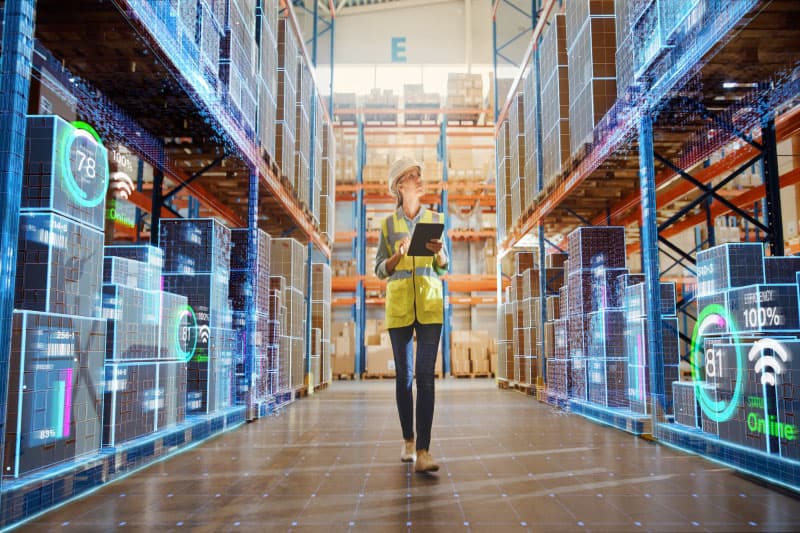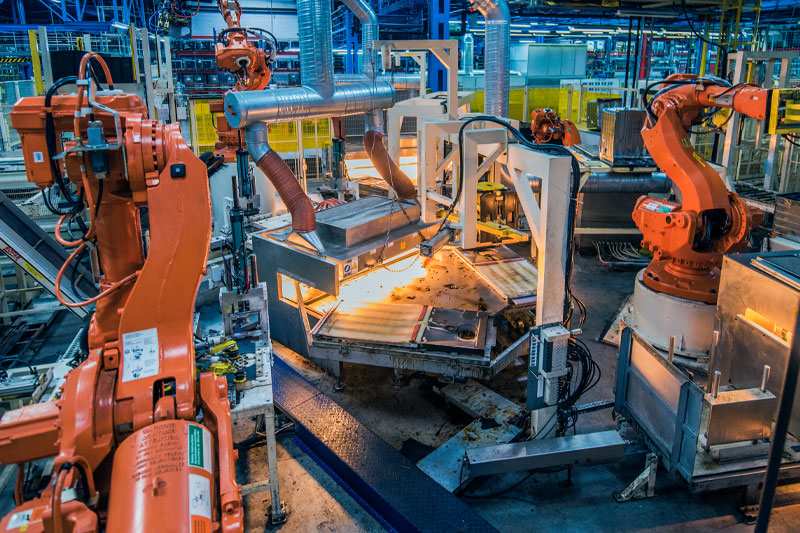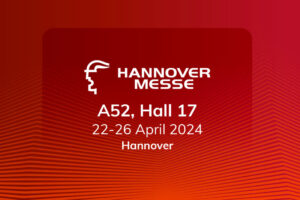Contents
IIoT - IoT for Manufacturing
When you are trying to stay competitive in a rapidly advancing world of technology it’s a good idea to embrace those new advances sooner, rather than later. For those in the industrial sectors, this means learning about and implementing the Industrial IoT. Similar to the everyday network that connects your mobile devices, this network connects the equipment and vehicles used by a business to a central computer server via a Real-Time Location System (RTLS).
Industrial IoT does much more than gather location data. Special sensors can be embedded in ID tags affixed to said equipment to record vital information about those assets, such as speed and temperature. At Litum, we help companies upgrade their production facilities with RTLS and industrial IoT technology to cut costs, improve productivity, and improve safety. Of course, every business is unique and requires a tailored plan for their IIOT.
How to Create a Cohesive Plan to Proceed with Industrial IoT
While manufacturers often produce different products, the basic process behind implementing industrial IoT systems is usually easy to initiate. Businesses need to identify what it is that they want to improve on in their daily operations, whether it be preventing forklift accidents, improve response time in case of an emergency, monitoring production output, or optimizing asset usage. The process of implementing one of Litum’s IoT solutions is fairly straightforward. Together with your project team, Litum experts:
- Analyze facility layout and calculate the number of anchors and gateways required to cover the area
- Select the right tags and sensors
- Customize the application software per your specific requirements and integrate with existing ERP systems if required
- Monitor outcome for a period of time and optimize the system.
The system should also be used in order to:
- Find/predict problem spots on the production line, or in the entire facility
- Implement changes in process/equipment usage to prevent them
Almost like the Japanese productivity method of “Kaizen“, this method of developing your IIOT involves continuous data gathering and adjustments to improve production. There are many areas where you can implement Industry 4.0 systems, from inventory management to labor productivity to asset utilization. Most companies already have a good idea of the sector that would benefit the most from the addition of industrial IoT. Start here with the initial process and branch outwards into other areas as you gain more experience using data gathered from an RTLS.
Selecting the IIoT System & Sensors
Litum experts can help you pick out the hardware and software that works best for your company. We usually start with an in-depth consultation to discuss production, the facility, and your needs. There are many options available for sensors to use on RFID tags worn by personnel, and tags affixed to equipment and vehicles. These devices can monitor:
- Temperature
- Pressure
- Level
- Flow
- Humidity
- Vibration
- Gases
To get an idea of what you’ll need, think about how your facility operates and again what you want to know about it. If you are trying to reduce accidents between vehicles, you might want tags with speed and vibration sensors installed. Those who want to see how their automated line is doing might also want to install pressure sensors, level, and flow meters.
Of course, the sensor information isn’t all of the data you’ll gather. Each RFID tag also provides important location and movement data that our software can use to calculate speed and timing. Both of these things are also useful for predicting movement in the future.
Processing the Data
You’ll need comprehensive RTLS software with features that are ideal for processing data gathered by your Internet of Things. Litum can provide a system with a number of useful reports and analyses to improve productivity, monitor inventory, track movement in the facility, and more. This data can also be combined to help you track down hiccups in the system.
For instance, our spaghetti diagrams display every path taken by most personnel and equipment. You can review this layout in conjunction with information showing the time taken to transport materials between points or for personnel to go from Point A to Point B. It can help you identify the most efficient routes for travel and identify areas in the facility where ‘traffic jams’ occur.

Use Industrial IoT Predictive Maintenance to Cut Repair Costs
Many IIoT companies also use this data for predictive maintenance, so they can prevent costly vehicle breakdowns that are not only more expensive to repair but slow down production too. This is done by gathering data from machines when they are operating normally during a process called condition monitoring. RFID tags can monitor normal vibration, temperatures, and even listen for sounds to create a profile of what is normal for your equipment.
Later, when these inputs start varying, the system can trigger a maintenance request that is sent to the appropriate personnel. This entire part of the process can be automated using our RTLS software, which is very helpful for reducing man-hours, costs, and keeping a facility productive.
Implementing Changes Based on Industrial IoT Data
In truth, there is no one solution for every business. You’ll still need to review the data and decide what to do to try and improve efficiency or minimize hazards. Those who have a flexible production that varies in type of product or location may not find as much use in automating their line, but IoT solutions can do much to improve safety, overtime, and reduce repair or loss expenses.
As you review data, you will notice areas that stand out. Problems with downtime or too much time spent finding lost tools. Once you identify the issue, you can refine the data gathered to track down potential causes and solutions that may naturally come to mind. With downtime due to broken vehicles, predictive maintenance may be an option to implement. Or, you can affix RFID tags to important tools and mobile equipment, so it’s easier to find.
Continuing to Gather Data
After changes are made to your production line or facility operations, you’ll want to implement IIOT in these areas to monitor the changes. This may mean entering new equipment into the RTLS software and affixing trackers, or setting up alerts to signal when someone isn’t following the new procedure.
Give it a few months of data collection to really see how your new updates are working out. At the end of this period, you can review everything again and compare it to the archived data prior to the changes. With regular monitoring and adjustments, companies can make vital improvements to their bottom line.
Tips for Implementing Industrial IoT in Your Facility
The transition to industrial IoT in your facility is a learning process that is well worth the effort. Your company will come through this transition period better able to compete in a national or global market.
Plus, RTLS can streamline operations and reduce everyday headaches like minor accidents and lost equipment. Before you move forward with adding IoT to your facility, we’ve also put together a few tips for you to consider when implementing this technology.
Don't Overdo It with Hardware
This technology is exciting, and many people want to get it into place as quickly as possible. It’s tempting for companies to invest in a lot of RFID tags with a variety of sensors in them before really thinking about what kind of information they want to gather. However, this can be a waste of effort and money. You’ll likely end up with too many sensors for your needs and get too much data to use efficiently.
We recommend thinking hard about what it is you really want to know from your equipment and staff movement. This should help you in selecting the right hardware for the job.
Update Legacy Machinery & Equipment
Before you get too far into industrial IoT, make sure that all of your equipment meets a minimum standard of modernity.
By replacing old analog panels with digital controls, you can do a lot to improve the productivity of a piece of equipment and gain support for maintenance needs.
These digital controls can also be connected to the internet, so you can control them remotely, if necessary.
Incorporate Good Security into IoT Solutions
Many manufacturers are concerned about maintaining a secure network, so their operations data isn’t hacked from outside.
If you are similarly concerned, you might want to speak with Litum representatives about incorporating strong security features into your platform.
We can also offer suggestions, such as limiting access to the RTLS software and setting up your own server to keep stored data onsite instead of using a cloud server.
Participate in Staff Training
Implementing a sophisticated Real-Time Location System (RTLS) with sensors within your facility and equipment requires comprehensive utilization to derive maximum benefits. As part of our services, akin to numerous Internet of Things (IoT) companies, we offer thorough training sessions covering the multifaceted features of our RTLS software and the effective utilization of RFID tags.
Moreover, it’s advisable to ensure key personnel dedicate additional time to acquaint themselves with the system, facilitating prompt responses to any arising issues or system alerts.
Furthermore, securing a proficient team for ongoing maintenance and servicing is imperative to uphold system efficiency, accuracy, and security. Our company extends continuous system support along with options for extended warranties to businesses.
If you’re keen on exploring the advantages of industrial IoT platforms tailored to your business, consider reaching out to Litum to arrange a consultation. With partners spanning numerous countries, we offer the opportunity for in-person meetings with staff and seamless installation of your new RTLS system and software. Discover more about the cutting-edge advancements in industrial IoT with Litum.
To delve deeper into how Litum can elevate your operations, contact with us today.



